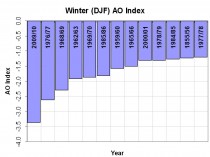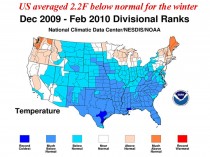Washington DC and many cities of the east and south had a warm to record warm summer (while parts of the west had a cold to record cold) with the average for the nation the 4th warmest on record. For Washington, it broke many of the records set in 1980 and 1988. It tied with the number of 90F days set in 1988 and fell just 12 days short of the number of 90F days for the year (a few additional still possible) set in 1980.
A hot summer is very typical when a strong La Nina follows a strong El Nino winter (1999, 1988, 1966) or when record strong arctic blocking in winter fades (1977). This past winter we saw a record for negative Arctic Oscillation (AO) beating out 1976/77 and 1965/66 (below, enlarged here).

The summer was 2.2F above normal for the nation, ranking it as fourth warmest (below, enlarged here).

That matches how much last winter the US averaged below normal (2.2F). Last winter was coldest in the south and southeast (in a few spots, coldest ever). Colder to the south of DC but recall DC and surroundings had a record seasonal snowfall (below, enlarged here).

Besides 1980, 1988, other hot summers included 1881, where this record from “Andy” out of the Naval Observatory shows an amazing summer following a very cold January/winter. He writes:
I am attaching a rather rare document, Washington DC weather records for the year 1881 taken at the Naval Observatory.
I have highlighted an incredible late summer, early autumn heat wave that got started on August 20th and did not really end until October 4th. There has never been anything remotely approaching the intensity and duration of this heat wave for so late in the year in modern times.
An unbelievable temperature of 108.5 was recorded on the very late date of September 7th! Also the average September average high temperature of 90.8 dwarfs anything you can find in recent years. One could argue that the site or thermometer might reflect a warm bias. Examining the data, June was actually quite cool and July was about average. And back then, no one was pushing an agenda!
The summer this year was characterized by hot days with high humidities and thus very warm nights. Nighttime lows were especially above the normal. Ironically many of the same areas with warmth this summer had very cool summers the last two years with a record/near record cold July in 2009 (below, enlarged here).

That was consistent with a summer after a La Nina winter, one with low solar and high latitude volcanic activity. Last summer and last winter we were told that was weather not climate. This makes any claims that a hot summer this year is indicative of a warming world disengenuous. With La Nina coming on, look for a cool summer again next year. With a negative PDO look for colder years ahead. This will accelerate when the Atlantic cools. The active hurricane season will remove some of the heat built up in the Atlantic by the El Nino suppressed activity last year and reduced winds (mixing) and increased sunshine with a suppressed jet stream, weakened suppresed subtropical high pressure due to record blocking this past winter.
--------------------
NOAA outsources climate data management
Anthony Watts, Watts Up With That
No mention in this press release of what it might actually accomplish. Meanwhile a full scale siting assessment and quality control analysis of the entire NWS COOP network remains undone. On the plus side, they won’t now be able to use the CRU excuse of “we are understaffed” to avoid the FOIA requests surely coming their way. h/t to Joe DAleo/John Coleman - Anthony
Contact: John Leslie FOR IMMEDIATE RELEASE
301-713-0214 Sept. 16, 2010
NOAA Awards Contract to Manage Climate Data Records
NOAA officials today announced that Global Science & Technology, Inc., of Greenbelt, Md., has been awarded a contract to help manage the agency’s satellite Climate Data Records (CDR) program, which is based at NOAA’s National Climatic Data Center in Asheville, N.C.
The contract has a one-year base period, with two one-year option periods. The total contract value is $10,307,788.80. The contract will enable Global Science & Technology to add up to 25 jobs at NCDC’s Asheville location.
Scientists use CDRs to detect, assess, model and predict climate change and variability. Decision-makers use this information to develop effective strategies to adapt to and mitigate the impacts of climate change in their local communities.
Through this contract, Global Science & Technology, Inc. will provide management support of the CDR program, including project control and oversight services, system and product development, and customer and community outreach.
“Global Science & Technology, Inc. brings experience as an industry leader to the CDR program, which is developing some of the most important climate data products in the world,” said Scott Hausman, acting director of NOAA’s NCDC.
Commenter Billyquiz says:
September 17, 2010 at 9:21 am
“At our 2008 corporate retreat, GST decided to embrace a “green” philosophy to address our dependence on petroleum (as both a company and as individual employees) and the threat that global warming has to life on Earth.” Gatekeeping anyone?
NOAA’s NCDC is the largest environmental data center in the world. NCDC data help the scientific community and policymakers assess global climate variability and trends. The work on this contract will support the suite of climate services that NOAA provides government, business and community leaders, so they can make informed decisions.
“This is a remarkable opportunity for the National Climatic Data Center and for western North Carolina to expand our climate research and create up to 25 new high-paying, stable jobs in our area,” said Rep. Heath Shuler. “NCDC is home to the world’s most impressive and comprehensive collection of climate data, and this is one more step forward in making our mountain region unsurpassed in climate research in America.”
Scientists, researchers and leaders in government and industry use monthly U.S. and global temperature reports from NCDC to help track trends and other changes in the world’s climate. These climate services have a wide range of practical uses, from helping farmers know what and when to plant, to guiding resource managers with critical decisions about water, energy and other vital assets.
NOAA’s mission is to understand and predict changes in the Earth’s environment, from the depths of the ocean to the surface of the sun, and to conserve and manage our coastal and marine resources.
Commenter Mike Haseler says:
September 17, 2010 at 9:38 am
In the UK, government statistics are normally outsourced when they want to avoid things like FOI law and being subject to parliamentary scrutiny...it also makes it a lot easier for the next administration just to dump the whole thing!
See more comments here.




